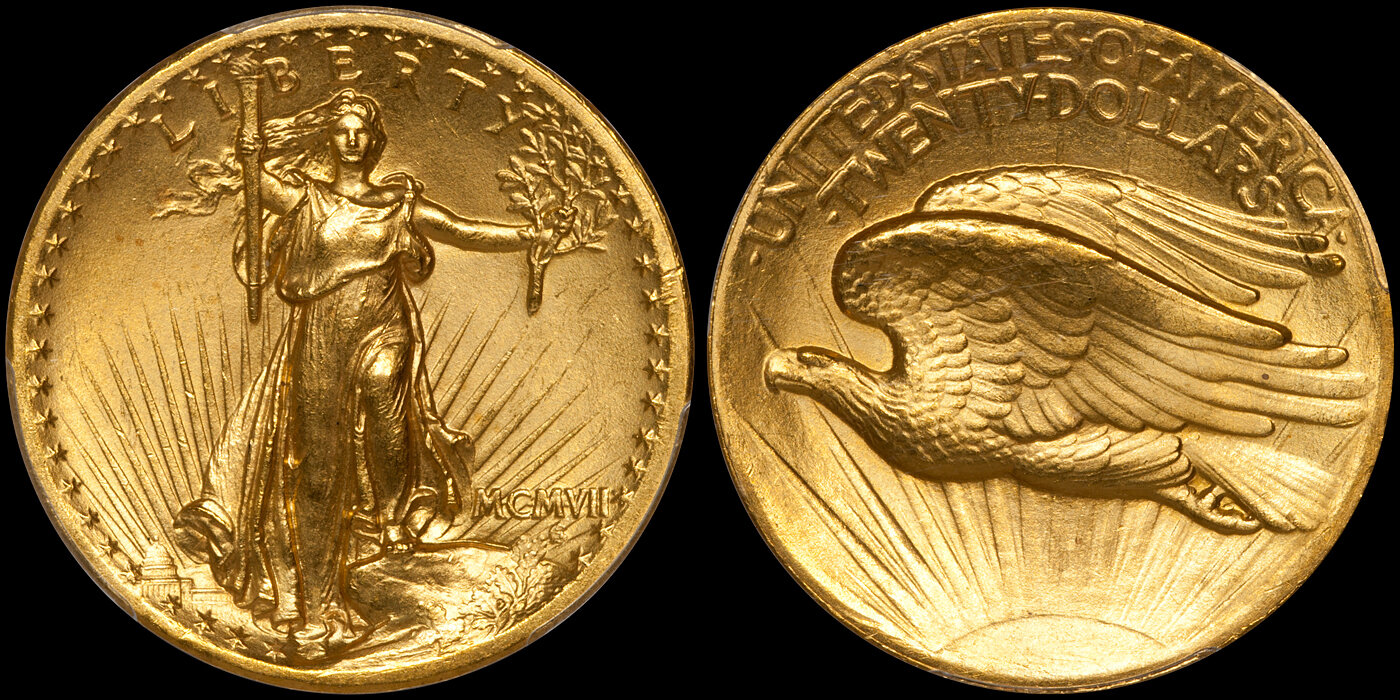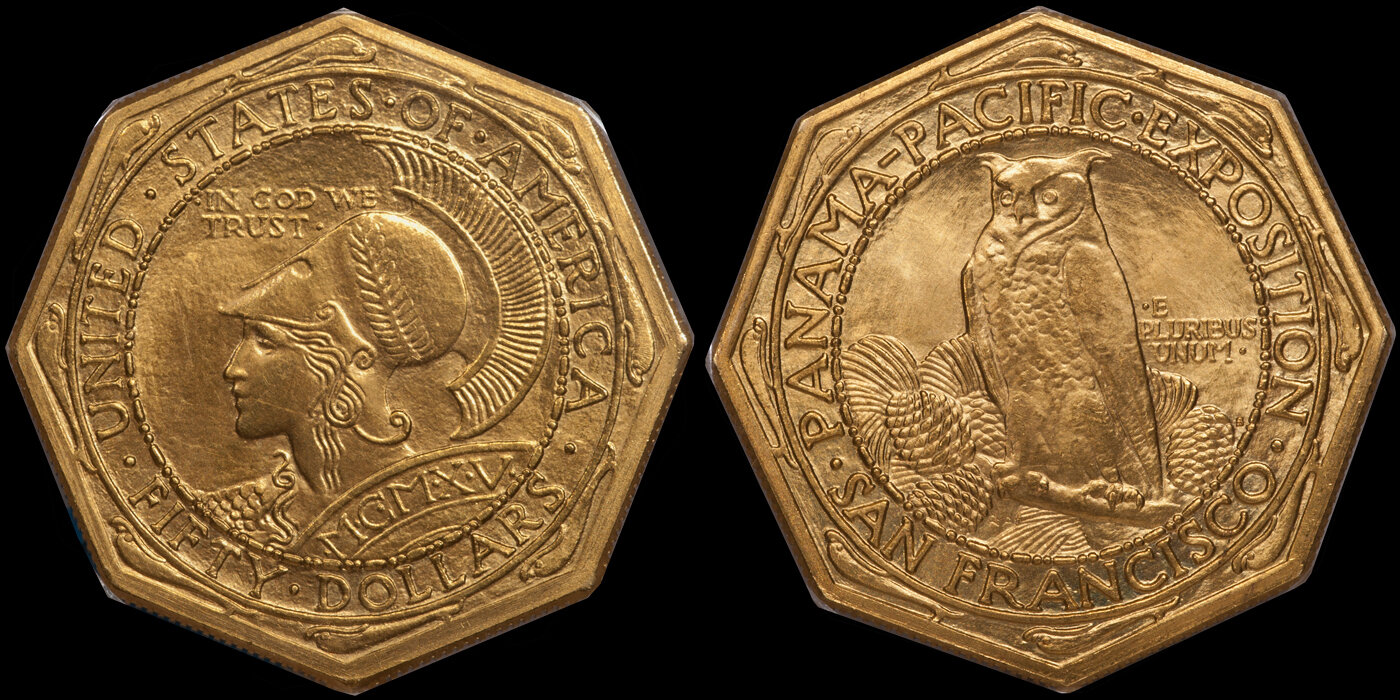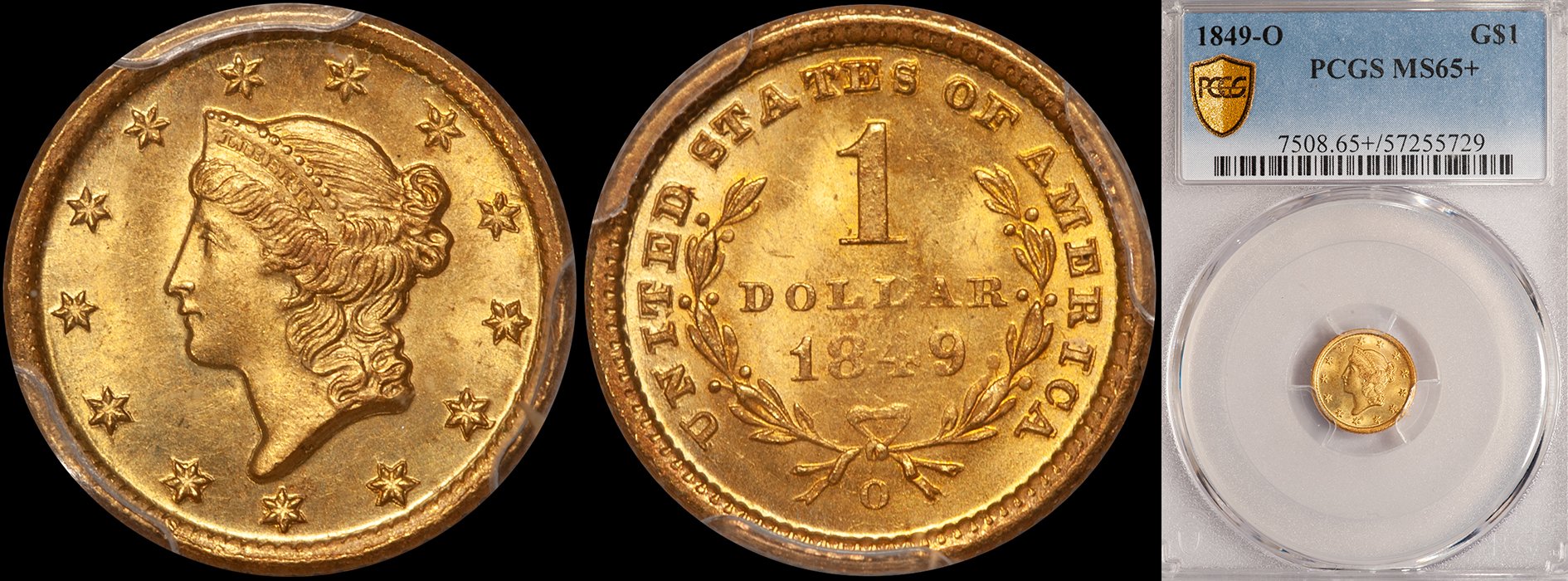Ten Trophy Gold Coins and Their Pitches
/I define a “Trophy Coin” as one which suitably combines rarity, appearance, and a great story in one neat package. Trophy coins aren’t necessarily the rarest pieces within a specific series. As an example, a 1907 High Relief is far from the rarest issue in the St. Gaudens series, yet for most collectors it is a Trophy Coin while a great rarity like a 1921 Saint in MS63 (and above) is considered more of a specialist’s issue.
Trophy coins, because of their strong multiple levels of demand, tend to be fully valued in regards to other coins. You’ll never read an article by me espousing how an MS64 High Relief is undervalued. But I know that a nice MS64 High Relief on my website will sell more quickly than many rarer issues which don’t have Trophy Coin status.
This article deals with gold Trophy Coins. By their very nature, trophy coins are expensive and this article will seem elitist, but if your coin budget is a few thousand dollars per issue, you just aren’t going to be a player in the Trophy coin market.
In addition to a brief discussion about each trophy coin, I’m going to include the “pitch” which makes these coins so unique and which gives them multiple levels of demand.
1. 1861-D Gold Dollar
1861-D $1.00 PCGS MS61
The Pitch: The only gold coin which can be positively attributed to Confederate manufacture. A coin which every Southerner should own!
The 1861-D is clearly the most desirable gold dollar and a strong case can be made for calling it the single most coveted issue from any southern branch mint. It has many things going for it: genuine rarity (fewer than 100 are known from a mintage estimated to be in the 750-1000 range), unique appearance, compelling backstory (struck by the Confederate forces after the mint had been seized from the Union forces), and multiple levels of collector demand.
The 1861-D dollar has become extremely popular in recent years and it now trades in the $40,000-50,000+ range for a decent example. I still like the growth potential for this issue, and it is possibly the best “investment” of any coin on this list due to its unusual co-status as collector coin and trophy coin.
2. 1796 No Stars Quarter Eagle
1796 No Stars $2.50 NGC AU55, ex Newman, courtesy of Heritage
The Pitch: Rare one-year type and first year of issue.
Only 963 examples were produced and while it is not the rarest early quarter eagle (that honor goes to the very rare but very esoteric 1804 13 star reverse) it is clearly the most popular issue of this type—if not the entire denomination.
This is an issue which has been regarded as a great coin long before the Trophy Coin concept even existed. It is truly rare but, for me, the thing about the 1796 No Stars that I find most appealing is its unique design. It is a minimalist’s dream with its stark obverse; a design which I far prefer to Stars Obverse type which was adapted later in 1796.
The 1796 No Stars quarter eagle has shown good price performance over the last few decades and I see no reason why this shouldn’t continue. With type collectors, quarter eagle specialists, early gold enthusiasts, and trophy coin buyers all competing for a limited number of problem-free examples, I like the future for the No Stars very much.
3. 1911-D Quarter Eagle
1911-D Strong D $2.50 PCGS MS64+ CAC
The Pitch: The rarest date in the most avidly collected (and the only completable) set of 20th century gold issues.
This is one of the few coins on this list which needs an asterisk. While I regard a Gem Uncirculated 1911-D quarter eagle as a trophy coin, I certainly don’t regard a circulated example as anything more than a widget. And, to a degree, this is true with lower-end Uncirculated (through MS63) examples as well.
The reason this issue deserves to be on the list is more marketing-driven than, say, a 1796 No Stars quarter eagle. The 1911-D is a condition rarity (unlike most of the other coins on this list) and its presence is a bit disingenuous as a result. While I freely admit this, for many collectors an MS65 1911-D quarter eagle is a dream coin and this is exactly what we are referring to when we discuss “trophy” issues.
Price levels for high-grade 1911-D quarter eagles have dropped in recent years, primarily due to a weakness in the Indian Head quarter eagle market. If I had to guess, I’d say this weakness is temporary and a carefully hand selected, CAC approved MS64 or MS65 should appreciate in anticipation of an influx of new collectors entering this area of the market.
4. 1875 Three Dollar
1875 $3.00 PCGS PR64 CAC, ex Eliasberg, courtesy of Heritage
The Pitch: Rare Proof-only issue with reported mintage of just 20 coins.
This is an issue whose presence on this list is likely to not be unanimously approved. It isn’t because the 1875 isn’t a rare coin—clearly it is. Any Trophy Coin controversy caused by the 1875 three dollar is more likely to be due to a lack of collector enthusiasm for this denomination. I am in the former camp because this coin is “sexy” and because it has been accorded Trophy Coin status for many generations. If I remember correctly, a Gem Proof 1875 three dollar sold for over $100,000 back in 1973, and it was the first six-figure United States gold coin.
Ironically, third-party grading has not been kind to the 1875 three dollar as it has proven, once and for all, that this issue was restruck ca. 1875-1876, as the total number known exceeds the reported original mintage. That said, the 1875 three dollar, in my opinion, is still an indisputable Trophy Coin.
The price performance for this issue has not been all that impressive given what Gem Proofs were worth two decades ago versus what they are worth now. But I expect three dollar gold pieces to become more popular sooner than later, and if and when this happens, the 1875 will regain its status as the King of Threes.
5. 1795 Small Eagle Half Eagle
1795 Small Eagle $5.00 PCGS AU58
The Pitch: First year of issue, and along with the similarly dated eagle, the first American gold coin.
I think that there would be very little argument with placing the 1795 half eagle on any Trophy Coin list. Who wouldn’t want to own a good-looking example of this historic issue? And the beauty of the 1795 Small Eagle half eagle is that it is available enough in better-than-average grades and it isn’t wildly expensive.
The level of demand for this coin has always been strong but I have noted an even greater demand in the past decade. Type collectors have always wanted a nice 1795 half eagle but now there is competition from other collectors as well. I wouldn’t necessarily regard just any 1795 small eagle as a Trophy Coin (even a nice EF, while something that I would personally be thrilled to buy for inventory, isn’t a true trophy). A higher grade example (in this case MS63 or above) with original color and choice surfaces would be a great addition to any Trophy Coin set.
I expect a coin like a 1795 half eagle to show excellent price appreciation in the coming years. These are the Old Masters of American coins, if you will, and while they are not as faddish as more modern issues, they have the core fundamentals which any issue needs for future appreciation.
6. Gem Indian Head Half Eagle
1908 Indian $5.00 PCGS MS65 CAC
The Pitch: In MS65, perhaps the most beautiful American regular issue gold coin and rarest 20th century type in Gem.
This choice is a bit of a stretch but it’s my list of Trophy Coins and I can stretch if I want to. The Indian Head half eagle is by far the rarest major gold type coin struck in the 20th century in higher grades. A properly graded MS65 or finer example, preferably with CAC approval, is not only a beautiful coin to look at—it is scarce from an absolute standpoint. I have always loved this design and even today, with looser grading standards and (current) lesser demand, Gems are hard to locate.
What I like about the Indian Head half eagle series is the variation of “looks” which the individual issues show. If you study this series even for a short while you’ll learn that a high grade 1908-S, as an example, has a very different appearance than a 1909-D. The luster is different, the color is different, and the strike is different. I find these differences to be interesting. What I really like about this series, though, is just how rare even a common date like a 1909-D is in properly graded MS65.
Price levels have dropped quite a bit on Gem Indian Head half eagle in the last few years and I attribute this to a few factors. The demand for this design in Gem Uncirculated is low due to a current lack of Indian Head half eagle specialists; for some reason the ebb and flow of serious collectors in this series is more pronounced than for other comparable series. Even collecting gem gold by type is currently out of fashion so type coin demand for common(er) dates in MS65 and higher is low. At the current level of $10,000-15,000 or so for a PCGS/CAC MS65 slightly better date, I love the value of this Trophy Coin.
7. 1795 or 1933 Eagle
1795 $10.00, 13 Leaves, PCGS AU53
The Pitch (es): First year of issue or last year of issue. The 1795 is the biggest-sized early gold coin while the 1933 eagle is the only legal-to-own gold coin from this year.
I anguished whether to choose the 1795 or 1933 eagle as my Trophy Coin and really couldn’t leave off either issue so…I decided to include both.
The 1795 eagle is not a dramatically rare coin—except in very high grades—but it is a coin which nearly any collector can relate to. If you think about the context in which this coin was issued, it has a fascinating backstory. In 1795, ten dollars was a tremendous amount of money. The average citizen never saw a gold eagle in 1795, let alone owned one, and these were more storehouses of value for banks or the very wealthy.
1795 eagles are not inexpensive (choice coins can run into the low seven figures) but given the age, beauty and historic/numismatic significance they possess, I think they are very fairly priced for a true Trophy Coin.
The 1933 is the yang to the 1795 eagle’s yin. Only a tiny fraction of the 312,500 originally struck escaped the melting pot and most are in higher grades. Of the three dozen or known, most grade MS64 to MS65 and a few really attractive Gems exist. These trade in the $500,000-750,000+ range and I would not be surprised to see properly graded MS66 examples break the million dollar threshold in the not-too-distant future.
8. Proof Liberty Head Double Eagle
1895 $20.00 PCGS PR64DCAM CAC
The Pitch: Big. Shiny. Rare. What’s not to like?
If I was given the chance to do a numismatic show & tell with a billionaire, I would bring as many Trophy Coins as I could find. And I’d start with big, flashy coins like better date pre-1900 Liberty Head double eagles in PR64 to PR66.
These coins check nearly every well-heeled collector’s hot boxes. Even a newbie collector or investor is going to like the way an 1893 double eagle looks in Gem Proof, especially if it shows full cameo contrast and it has an across-the-room black and white appearance. Nearly every pre-1900 issue has an original mintage of under 100, and even a “common date” like an 1896 still has a likely surviving population of fewer than 50 coins; less in Gem Proof.
Our unnamed billionaire might not want to start a date run of Proof Twenties, but it is certainly likely he’d want to buy at least one example for type purposes, and maybe even expand in to a three coin set with a Type One, Type Two and Type Three issue included. For just a shade over $100,000 he could begin this endeavor with a really nice Type Three. I personally like the growth potential of such coins quite a bit and have lately sold a number of PR64 and PR65 Type Three double eagles.
9. 1907 High Relief Double Eagle
MCMVII (1907) High Relief $20.00 PCGS MS64+ CAC
The Pitch: America’s most beautiful coin. The Trophy Coin to end all Trophy Coins.
You can’t pick more of a trophy coin than a High Relief double eagle (well actually you could—an Extremely High relief—but even this list has some price parameters and $3 million+ is probably out of the range of most readers of this article).
I won’t replay the backstory of this coin as it has been told many times, but suffice to say even with considerable bastardization by the mint, the design for this coin is truly beautiful and it appeals to virtually all collectors.
High Reliefs have been good storehouses of value in recent years. They tend not to rise in price all that much or drop in price either. As a Trophy Coin, I personally like examples which are graded MS64 and MS65 and approved by CAC. From personal experience, I never have trouble quickly selling a nice High Relief when it is listed on my website. They are not crazy expensive relative to their strong demand.
10. 1915-S Pan-Pac Octagonal $50.00
1915-S Panama Pacific Octagonal $50.00, PCGS MS64+
The Pitch: The biggest coin, size-wise, to be struck at the U.S. mint. Big, beautiful and, in the case of the octagonal design, highly unusual appearance.
The Pitch: The biggest coin, size-wise, to be struck at the U.S. mint. Big, beautiful and, in the case of the octagonal design, showing a highly unusual appearance.
If you sit and think about it, the Pan-Pac Octagonal is a gimmick coin. It's huge, it's eight-sided, and even by 1915 standards, and its mintage of 645 is presumptuous at best. That said, it is the Mac Daddy of all Trophy Coins, and it is a coin that every rich collector or investor can’t resist.
Even someone like me, who doesn’t care for gold commemoratives, loves the Pan-Pac Octagonal. I realize that the Round $50 is considerably scarcer, especially in Gem, but the Octagonal is so, well, odd. I love the massiveness of this coin and the way that even encased in a PCGS holder, it feels like a little brick of gold. I love the Robert Aitken design. And, of course, I love that crazy, crazy shape.
This is an issue which I think has great investment potential for those individuals who think this way.
What are you favorite Trophy Coins? Did I leave any coins off this list that you think should be included? Email me at dwn@ont.com with your thoughts.
Do you buy rare gold coins? Do you have coins to sell? Would you like to have the world’s leading expert help you assemble a set of coins? Contact me, Doug Winter, directly at (214) 675-9897 or by email at dwn@ont.com.




















